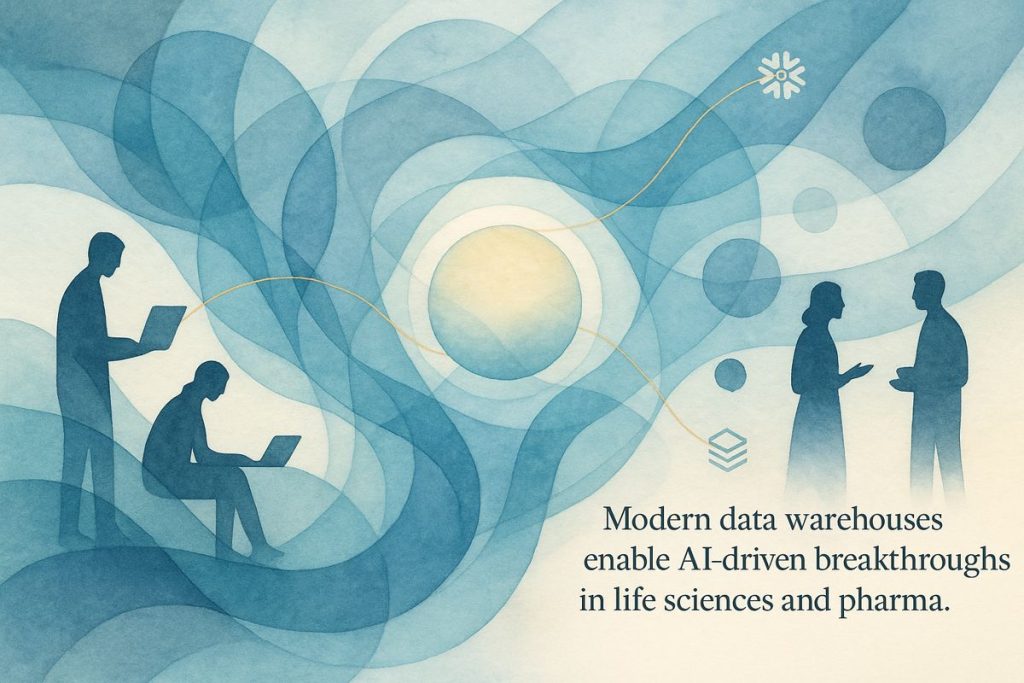Life sciences data warehousing is changing fast, moving from old server rooms to the flexible world of cloud computing. Modern tools like Snowflake and Databricks let scientists connect and use data easily, while automation and AI make everything quicker and smarter. Strict rules keep the data safe and clean, thanks to built-in protections and smart tracking. The process of moving to the cloud happens step by step, with teamwork and careful planning making sure nothing goes wrong. All these changes help scientists work faster and create new discoveries with less hassle.
What are the key trends in modernizing life sciences data warehousing?
Modern life sciences data warehousing is driven by cloud migration, interoperability between platforms like Snowflake and Databricks, AI-driven automation, and robust data governance. These advancements enable seamless data integration, regulatory compliance, real-time analytics, and incremental migration—empowering organizations to innovate while maintaining data integrity.
The Cloud: Not Just Vapor—A Concrete Bedrock
Picture the average pharmaceutical data warehouse from a decade ago: a humming, fluorescent-lit room, racks of servers emitting a faint tang of ozone, and a team huddled over an Oracle console. If you listen closely, you can almost hear the dull hum of a hard drive spinning at 7,200 rpm. Fast-forward to 2025, and, well, everything’s gone cloud-shaped. Snowflake, with its hyperspectral data-sharing prowess, and Databricks, that Apache Spark-fueled juggernaut, have upended expectations. No more forklift upgrades; no more capital expenditure hangovers. Just elastic compute and consumption-based pricing—the financial equivalent of swapping a leaden anchor for a hot air balloon.
Accenture, Capgemini, and Deloitte parade their methodologies, each promising to shepherd you painlessly from on-premises purgatory to cloud nirvana. I’d love to say it’s always painless, but—confession time—I once scheduled a test migration for 3 a.m. and spent the next three days debugging orphaned ETL jobs. The lesson? Cloud migration is less a one-off leap and more a series of amphibious landings. You assess, you plan, you pilot, and you optimize. Automation isn’t just a timesaver; it’s a shield against human error—think of it as digital bubble wrap around your most critical workloads. Real-time insights, once a pipedream, now arrive with the urgency of an espresso shot—hot, fast, and slightly addictive.
Snowflake, Databricks, and the Dance of Interoperability
Snowflake’s compliance pedigree is practically Talmudic—fine-grained controls, lineage tracking, and enough SOC certifications to make a regulator weep with joy. Databricks, on the other hand, is the mad-scientist cousin: optimized for AI, big data, and all things ML. In a recent industry hackathon, I watched a team wring a 3x speed boost out of Databricks for a genomics pipeline—my skepticism (and envy) briefly eclipsed my morning coffee high.
But here’s the twist: it’s not either/or. 2025’s watchword is interoperability. Catalog-Linked Databases and connectors now let you shuttle data between Snowflake and Databricks as easily as swapping train lines at Union Station. This hybrid choreography means you can incrementally modernize—run your old and new worlds in parallel, and no one’s left clutching their pearls when something goes sideways. I sometimes wonder, are we orchestrating data or just improvising jazz? Either way, the result sings.
Architectures for Tomorrow: Less Blueprint, More Palimpsest
Industry reference architectures are no longer rigid blueprints—they’re more like palimpsests, layers of best practices overwritten by each new advance. You want to blend structured clinical trial data with the messy, unstructured stuff—patient forums, sensor logs, NMR spectra? Enter Delta Lake, Snowpark, and the likes of Informatica and Fivetran, stitching disparate sources together like a skilled tailor.
The AI-driven warehouse is more than a buzzword: it’s a self-healing organism. Automated ETL, predictive analytics, and orchestration tools have trimmed the fat from what used to be a lumbering process. Suddenly, your best data engineer spends her time modeling pharmacokinetic outliers, not fighting with cron jobs. (I’ll admit, I miss the occasional late-night ETL firefight—it had a gritty charm. But progress, like a well-brewed cup, is hard to resist.)
Data Governance: The Unsung Hero (Or, Why Compliance Eats Strategy for Breakfast)
Life sciences doesn’t get to play fast and loose with data. HIPAA, GxP, and a whole alphabet soup of regulations demand rigor. Snowflake and Databricks now come with governance frameworks baked in: cataloging, access controls, automated quality checks. I once tried to shortcut lineage documentation—never again. The auditors found me out, and my cheeks still burn at the memory. Governance isn’t just a box-ticking exercise; it’s the scaffolding that lets you build AI-ready ecosystems without waking up to a compliance nightmare.
The integration of data lakes and warehouses has created a single source of truth—at least, as close as the real world allows. When the board demands a machine learning model for predicting adverse events, you can deliver, knowing your data’s both sound and sanctioned. Relief is a real emotion, and, in this line of work, it sometimes tastes like a well-deserved pastry after a clean audit.
Migration Methodologies and the Human Factor
The consulting giants agree: incremental beats big-bang. A phased approach—assess, pilot, migrate, validate—keeps business continuity intact. I’m haunted by the specter of failed cutovers (it’s usually a Friday afternoon, isn’t it?). These days, I build in rollback strategies and real-time sync with the zeal of a convert. Oddly enough, it works.
Collaboration is non-negotiable. Whether leaning on Accenture’s sector-specific wisdom, Capgemini’s frameworks, or Deloitte’s regulatory savvy, the right partnership feels less like outsourcing and more like assembling an Avengers squad for your data. The only thing missing is the spandex.
—
Modernizing the life sciences data warehouse is part odyssey, part chess match. With the right mix of cloud, automation, interoperability, and, above all, a dash of human stubbornness, the path forward isn’t just possible—it’s exhilarating. Or maybe that’s the caffeine talking.
